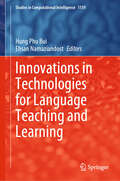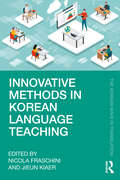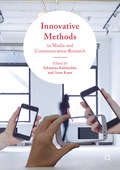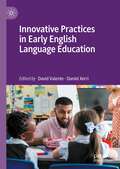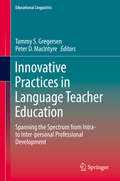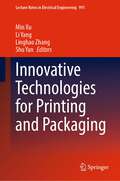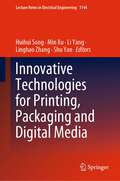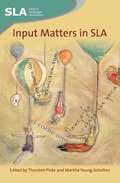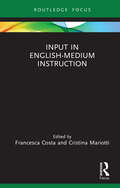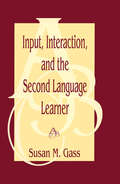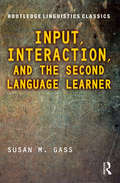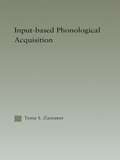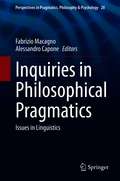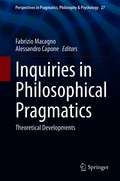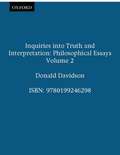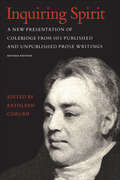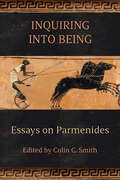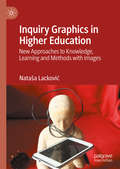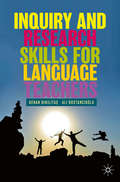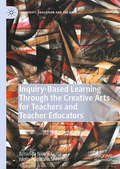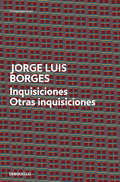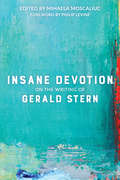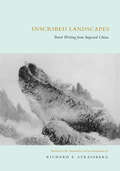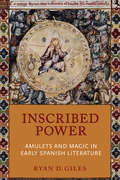- Table View
- List View
Innovations in Technologies for Language Teaching and Learning (Studies in Computational Intelligence #1159)
by Hung Phu Bui Ehsan NamaziandostThis edited book discusses the current issues and reports research conducted around the world. The advent of technology has changed the landscape of language education. The chapter topics are quite diverse, targeting the needs of undergraduate and graduate students and researchers. It views the mosaic of the field from cognitive, affective, educational, and educational perspectives. All the chapters give implications for further advances in technology and education.
Innovative Methods in Korean Language Teaching (The Korean Wave in Translation)
by Jieun Kiaer Nicola FraschiniInnovative Methods in Korean Language Teaching showcases research-based and experience-based contributions and reflections on the potential of adopting technological and non-technological innovations to promote Korean language students’ learning.The chapters included in this book consider a wide range of innovative technologies and approaches, such as large language models, virtual reality solutions, metaverse platforms, multimodal teaching, and critical pedagogy, and represent a variety of geographical learning contexts from North America to Europe, from Korea to the broader Asia-Pacific region. Overall, these contributions make the case for embracing new technologies instead of banning them and for accepting pedagogical shifts that take into consideration contemporary understandings of the communication, teaching, and learning processes.This book will be of interest to graduate students, researchers, and practitioners of Korean language education and to those working on language teaching and learning in general, to inform future teaching practices through careful consideration of contemporary technologies and teaching approaches.
Innovative Methods in Media and Communication Research
by Sebastian Kubitschko Anne KaunThis collection reflects the need for suitable methods to answer emerging questions that result from the ever-changing media environment. As media technologies and infrastructures become inseparably interwoven with social constellations, scholars from varying disciplines increasingly investigate their characteristics, functioning, relevance and impact - facing new methodological challenges as well as opportunities. Innovative Methods in Media and Communication Research engages with the substantial need to rethink established methods to research acute changes in the media environment. The book gathers chapters dedicated to the multifacetedness and liveliness of emerging methods - from lifelogging and ethnography to digital methods and visualization - while embedding them in the rich history of interdisciplinary empirical research. Innovation here is a call for widening and rethinking research methods to stimulate a sophisticated debate on and exploration of contemporary methodological approaches for scholars at various levels of academic life. Accompanied by introductory sections of prominent scholars, the majority of empirical studies gathered in this volume are accomplished through early-career scholars who strive to advance cutting-edge and in parts even provocative approaches for the study of media and communication.
Innovative Practices in Early English Language Education
by Daniel Xerri David ValenteThis book shines a light on novel and less familiar domains of early English language education for children aged 3 to 12, in mainstream and out-of-school settings. Enveloping the volume is the making of creative connections to wider educational philosophies which extend beyond the confines of a narrow linguistic lens. In reconciling the theory-practice divide in English language education, each chapter presents a synthesis of research issues leading to a practical showcase of ideas. Organised in two main parts, the first focuses on innovations within classroom practice, curriculum development, and child-centred assessment, exploring areas which have either received insufficient attention and/or have been reimagined through fresh perspectives. The second part explores innovations in pre- and in-service teacher education contexts and focuses on lesser-known and/or underexplored topics, including bridging general and language education, multilingualism, in-depth learning, metacognition, and pragmatics. This is a timely publication for teacher educators and practitioners alike.
Innovative Practices in Language Teacher Education
by Peter D. Macintyre Tammy S. GregersenThis volume addresses innovations in language teacher education, offering a diversity of personal/psychological perspectives and topics in the theory and/or practice in language teacher education. The text deals with innovations in teaching for learning, teacher autonomy, dynamic self-reflection, peace education, professionalism, action research, socio-emotional intelligence, embodiment, professional development, NeuroELT, and more. Organized in three sections, the chapters inspire readers to reflect upon what it means to grow as a teacher as they navigate the intra- to inter-personal continuum. The editors draw the main themes together and discuss them in light of an innovations framework developed by Rogers (including relative advantage, compatibility, complexity, trialability and observability) in order to express, in concrete terms, the ways in which each idea can be considered innovative. Throughout the anthology, the reader will find specific, novel ways in which to work towards good practice in language teacher education.
Innovative Technologies for Printing and Packaging (Lecture Notes in Electrical Engineering #991)
by Min Xu Li Yang Shu Yan Linghao ZhangThis book includes original, peer-reviewed research papers from the 13th China Academic Conference on Printing and Packaging (CACPP 2022), held in Jinan, China, on November 10-12, 2022. The proceedings cover the recent findings in color science and technology, image processing technology, digital media technology, mechanical and electronic engineering and numerical control, materials and detection, digital process management technology in printing and packaging, and other technologies. As such, the book is of interest to university researchers, R&D engineers, and graduate students in the field of graphic arts, packaging, color science, image science, material science, computer science, digital media, network technology, and smart manufacturing technology.
Innovative Technologies for Printing, Packaging and Digital Media (Lecture Notes in Electrical Engineering #1144)
by Min Xu Li Yang Shu Yan Linghao Zhang Huihui SongThis book includes original, peer-reviewed research papers from the 14th China Academic Conference on Printing and Packaging (CACPP 2023), held in Beijing, China on November 24-26, 2023. The proceedings cover the latest findings in color science and technology, image processing technology, digital media technology, mechanical and electronic engineering and numerical control, materials and detection, printing and packaging technology, and so on. As such, the book is of interest to university researchers, R&D engineers and graduate students in the fields of color science, image science, materials science, computer science, digital media, network technology, smart manufacturing technology and printing and packaging.
Input (Elements in Second Language Acquisition)
by John TruscottInput is the name of a topic – the way that language 'out there' impacts the development of interlanguage, within the individual. It is perhaps the most important aspect of second language learning. This Element offers an overview of the key concepts related to input and the major lines of research exploring its nature and its role in second language learning. It then puts things together into a coherent, if controversial, picture of input and its role in development, emphasizing the place of consciousness. In this and most other current perspectives, implicit (unconscious) input-based learning is the heart of second language acquisition. This suggests two general options for teaching: (a) trust the natural implicit processes, trying to create optimal conditions for them; (b) direct those processes to selected features of the input, probably using explicit instruction. The conclusion is that (a) appears preferable.
Input Matters in SLA
by Martha Young-Scholten Thorsten PiskeThis volume bridges the knowledge gap between second language acquisition researchers and second language pedagogy professionals in its focus on a topic of mutual interest: input. The reader-friendly contributions from seasoned researchers including Stephen Krashen, Bill VanPatten and new voices offer a wide range of existing and new perspectives on the matter of input. A rare feature of the book is that it includes extensive coverage by experts including James Flege and Alene Moyer of the acquisition of the sound system of a second language, where input seems to matter most. Those who are just making their acquaintance with second language acquisition research or updating their knowledge will find the editors' introductory chapter on past and current issues in the field particularly useful.
Input in English-Medium Instruction (Routledge Focus on English-Medium Instruction in Higher Education)
by Francesca Costa Cristina MariottiThis edited book investigates the input provided by lecturers in English-Medium Instruction (EMI) to reveal the characteristics of both written and oral input in EMI settings and their pedagogical implications. The book works on two assumptions: firstly, that field exposure to input is the prime mover of the teaching-learning process and secondly, that its quality is fundamental for the development of discipline-specific knowledge with particular reference to university settings. The volume is timely as it contains original research addressing both theoretical reflections and practical information on how content lecturers can enhance the effectiveness of their teaching practice through English including a relatively unexplored and increasingly relevant topic represented by the synergy between spoken input and written and multimodal materials. Moreover, it provides insight for EAP teachers and EMI training professionals into how lecturer training programmes and activities can be improved by focusing on communicative functions and presentation strategies that can selectively address and improve students’ mastery of disciplinary discourse.
Input, Interaction, and the Second Language Learner
by Susan M. GassThis volume provides a definitive view of the relationship between input, interaction, and second language acquisition. In so doing, it should prove useful to those whose major concern is with the acquisition of a second or foreign language as well as for those who are primarily interested in these issues from a pedagogical perspective. The book does not explicate or advocate a particular teaching methodology, but does attempt to lay out some of the underpinnings of what is involved in interaction -- what it is and what purpose it serves.Research in second language acquisition is concerned with the knowledge that second language learners do and do not acquire and how that knowledge comes about. This book ties these issues together from three perspectives -- input/interaction framework, information-processing, and learnability.
Input, Interaction, and the Second Language Learner: Second Edition (Routledge Linguistics Classics)
by Susan M. GassTwenty years after its first publication, Susan M. Gass’s Input, Interaction, and the Second Language Learner has become a classical text in the field of second language acquisition (SLA). This new printing includes the original text, along with a new preface that comprises individual consultations between the author and Alison Mackey, Rod Ellis, and Mike Long on the importance of the project two decades later. The volume provides an important view of the relationship between input, interaction, and SLA. In so doing, it should prove useful to those whose major concern is with the acquisition of a second or foreign language, as well as those who are primarily interested in these issues from a pedagogical perspective. The book does not explicate or advocate a particular teaching methodology, but does attempt to lay out some of the underpinnings of what is involved in interaction—what interaction is and what purpose it serves. Research in SLA is concerned with the knowledge that second language learners do and do not acquire, and how that knowledge comes about. This book ties these issues together from three perspectives: the input/interaction framework, information-processing, and learnability. This Routledge Linguistics Classic remains a key text for all SLA scholars and an essential supplementary volume for students on SLA courses.
Input-based Phonological Acquisition (Outstanding Dissertations in Linguistics)
by Tania ZamunerThis book provides an analysis of two theories of language acquisition: the theory that acquisition is primarily mediated by innate properties of language provided by universal grammar, and the opposing theory that language is acquired based on the patterns in the ambient language. A problem not often considered is that these two theories are confounded because the structures that are frequent across languages are also typically the most frequent within a specific language. In addition, the innate theory of language acquisition is difficult to quantify and qualify. Using cross-linguistic, corpus and experimental approaches, this book attempts to contrast these theories through an examination of the acquisition of word-final consonants in English.
Inquiries in Philosophical Pragmatics: Issues in Linguistics (Perspectives in Pragmatics, Philosophy & Psychology #28)
by Fabrizio Macagno Alessandro CaponeTogether with the first volume “Inquiries in philosophical pragmatics: Theoretical developments,” this book collects contributions that represent the state of the art on the interconnection between pragmatics and philosophy. While the first volume presents the philosophical dimension of pragmatics, showing the path from theoretical advances to practical uses and approaches, this second volume offers a specular view on this discipline. Instead of adopting the top-down view of the first volume, this collection of eleven chapters starts from the analysis of linguistic data – which include texts and discourses in different languages, different types of dialogues, different types of interactions, and different modes for expressing meaning – looking for the regularities that govern our production and processing. The chapters are ordered according to their relationship with the themes and methods that define the field of pragmatics. The more explored and classical linguistic issues such as prototype-based generalizations, scalar implicatures, and temporal ordering, lead gradually to the more recent and debated topic of slurs and pejorative language, and finally to the interdisciplinary and more pioneering works addressing specific context of language use, such as marketplace interactions, courtroom speeches, schizophrenic discourse, literary texts for children, and multimedia communication.Chapter 12 is available open access under a Creative Commons Attribution 4.0 International License via link.springer.com.
Inquiries in Philosophical Pragmatics: Theoretical Developments (Perspectives in Pragmatics, Philosophy & Psychology #27)
by Fabrizio Macagno Alessandro CaponeTogether with the volume “Inquiries in philosophical pragmatics: Linguistic and theoretical issues,” this book provides a journey through the more recent developments of pragmatics, considering both its philosophical and linguistic nature. This first volume is devoted to the theoretical models developed from a philosophical perspective, including both the newest advances of the classical theories and approaches, and pioneering and interdisciplinary ideas proposed to face the challenges of the fields and areas of practice and analysis. The topics investigated, which include implicatures, reference, presupposition, speech acts, metaphor, relevance, and common ground, represent the core of the state of the art in philosophical pragmatics. Research on these matters have been continuously changing the way that we can look at them. This book serves as a collection of works from the most eminent authors who represent the theoretical developments of the approaches that defined this field, together with the new philosophical insights coming from more applied disciplines such as argumentation, discourse analysis, or linguistics. The combination of these two perspectives provides a unique outline of the current research in pragmatics.
Inquiries into Truth and Interpretation 2nd Edition
by Donald DavidsonNow in a new edition, this volume updates Davidson's exceptional Inquiries into Truth and Interpretation (1984), which set out his enormously influential philosophy of language. The original volume remains a central point of reference, and a focus of controversy, with its impact extending into linguistic theory, philosophy of mind, and epistemology. Addressing a central question-what it is for words to mean what they do-and featuring a previously uncollected, additional essay, this work will appeal to a wide audience of philosophers, linguists, and psychologists.
Inquiring Spirit: A New Presentation of Coleridge from His Published and Unpublished Prose Writings (Revised Edition)
by Kathleen CoburnWhen this work was first prepared for publication in 1949 the Notebooks and Collected Letters were still in manuscript, and many of the printed works, if not unavailable, were scarce. The continuing publication of Coleridge's works has not lessened the demand for a general introduction to Coleridge's mind and its workings. Selections from works including The Friend, Essays on His Own Times, Aids to Reflection, the Statesman's Manual, Confessions of an Inquiring Spirit, and Table Talk, and from other lesser known works are arranged by topic. The subjects – psychology, education, language, logic and philosophy, literary criticism, the arts, science, society, religion and his contemporaries – reflect the astonishing range of Coleridge's intellectual interests. The revised edition of this anthology is still the best introduction to the prose works of an inquiring spirit.There is a fine introductory essay, and each section has an introduction of its own. The annotation is apt, and the index efficient. The whole book, in short, has been ordered with the distinction which is characteristic of Professor Coburn.
Inquiring into Being: Essays on Parmenides (SUNY series in Ancient Greek Philosophy)
by Colin C. SmithNew essays on early Greek natural philosopher Parmenides, who is perhaps the originator of metaphysics.Inquiring into Being is a study of Parmenides, the early Greek pre-Socratic philosopher often credited as the first metaphysician and whose sole written work was a philosophical poem. In his poem, Parmenides has a narrating goddess character indicate the sense of being that must be and cannot be as a corrective to the errors mortals make when accounting for the ultimate nature of reality while showing a keen scientific understanding of natural phenomena. Inquiring into Being brings together and further develops recent work on Parmenides and the surviving fragments of his text through twelve chapters by scholars from the United States and United Kingdom working in analytic and continental philosophy, classics, political theory, literary theory, and the history of science. It serves as a guide through many of the interpretive controversies in Parmenides's poem while offering new insights into Parmenides's role as poet, scientist, natural philosopher, and investigator into the nature of being.
Inquiry Graphics in Higher Education: New Approaches to Knowledge, Learning and Methods with Images
by Nataša LackovićThis book introduces the concept of Inquiry Graphics, which positions graphics as significant and integrated tools of inquiry in higher education teaching and research. Simply put, the book explores the nuances of thinking and learning with digital images as types of graphics. Although the amount of images in modern life is overwhelming, they have been scarcely explored and understood as integral to concept and knowledge development within higher education practice. This book reflects on why and how digital photographs can be adapted and used in teaching and research contexts. It provides practical examples and applications, as well as theoretical foundations, building on a range of perspectives, such as Peircean triadic sign and approaches to conceptual development. Ultimately, it builds on diverse approaches to make a case for exploring knowledge and analysing concepts and images in a non-dualist and pluralist manner. This unique book will appeal to scholars and students in education studies and educational research, media and communication, and anyone interested in applied semiotics, visual and multimodal pedagogy and learning.
Inquiry and Research Skills for Language Teachers
by Kenan Dikilitaş Ali BostancıoğluThis book equips pre-service language teachers with research and inquiry skills which they can use in the course of their classroom teaching. Research is presented not as an additional burden in teachers’ busy lives but as an integrated tool for satisfying their curiosity, developing an investigative stance, and strengthening the links between theory and practice. Over the course of the book, the authors introduce and encourage the use of pedagogically exploitable pedagogic-research activities (PEPRAs) to develop a deeper understanding of pedagogic issues in an engaging, supportive, and collaborative way. This book will be of interest to students and instructors on TESOL and related courses, as well as practitioners working in the teacher training sector.
Inquiry-Based Learning Through the Creative Arts for Teachers and Teacher Educators (Creativity, Education and the Arts)
by Amanda Nicole Gulla Molly Hamilton ShermanThis book is a theoretical and practical guide to implementing an inquiry-based approach to teaching which centers creative responses to works of art in curriculum. Guided by Maxine Greene’s philosophy of Aesthetic Education, the authors discuss the social justice implications of marginalized students having access to the arts and opportunities to find their voices through creative expression. They aim to demystify the process of inquiry-based learning through the arts for teachers and teacher educators by offering examples of lessons taught in high school classrooms and graduate level teaching methods courses. Examples of student writing and art work show how creative interactions with the arts can help learners of all ages deepen their skills as readers, writers, and thinkers.
Inquisiciones | Otras inquisiciones: Ensayo
by Jorge Luis BorgesSe reúnen por primera vez en su solo volumen los textos Inquisiciones y Otras inquisiciones, que abren algunos de los temas que serán recurrentes en la estética del autor. Este feliz volumen, inédito como tal hasta hoy, se compone de dos libros dados a imprenta con más de un cuarto de siglo de diferencia, la que separa 1925 de 1952. No obstante, sus ensayos pertenecen a un mismo diálogo, el de Borges con la historia literaria, el del lector con el escritor. De entre ellos, «Menoscabo y grandeza de Quevedo» señala los rostros múltiples del autor; «La nadería de la personalidad» quiebra el conjunto del yo; «La flor de Coleridge» reivindica la supremacía de la tradición; y «Kafka y sus precursores», por ejemplo, cuestiona el sentido de las influencias. «La literatura no es agotable, por la suficiente y simple razón de que un solo libro no lo es. El librono es un ente incomunicado: es una relación, es un eje de innumerables relaciones.»
Insane Devotion: On the Writing of Gerald Stern
by Philip Levine Mihaela MoscaliucGerald Stern has been a significant presence and an impassioned and idiosyncratic voice in twentieth and twenty-first-century American poetry. Insane Devotion is a retrospective of his career and features fourteen writers, critics, and poets examining the themes, stylistic traits, and craft of a poet who has shaped and inspired American verse for generations.The essays and interviews in Insane Devotion paint a broad picture of a man made whole by the influence of the written word. They touch on the contentious and nuanced stance of Judaism in the breadth of Stern's work and explore Stern's capacious memory and his use of personal history to illuminate our common humanity. What is revealed is a poet of complexity and heart, often tender, often outraged. As Philip Levine writes in his lyrical foreword to the volume, Stern is both sweet and spiky, "a born teacher who can teach me to see the universe in an acorn and hear the music of the lost in an empty Pepsi can."
Inscribed Landscapes: Travel Writing from Imperial China
by Richard E. StrassbergAlongside the scores of travel books about China written by foreign visitors, Chinese travelers' impressions of their own country rarely appear in translation. This anthology is the only comprehensive collection in English of Chinese travel writing from the first century A.D. through the nineteenth. Early examples of the genre describe sites important for their geography, history, and role in cultural mythology, but by the T'ang dynasty in the mid-eighth century certain historiographical and poetic discourses converged to form the "travel account" (yu-chi) and later the "travel diary" (jih-chi) as vehicles of personal expression and autobiography. These first-person narratives provide rich material for understanding the attitudes of Chinese literati toward place, nature, politics, and the self.The anthology is abundantly illustrated with paintings, portraits, maps, and drawings. Each selection is meticulously translated, carefully annotated, and prefaced by a brief description of the writer's life and work. The entire collection is introduced by an in-depth survey of the rise of Chinese travel writing as a cultural phenomenon. Inscribed Landscapes provides a unique resource for travelers as well as for scholars of Chinese literature, art, and history.
Inscribed Power: Amulets and Magic in Early Spanish Literature
by Ryan D. GilesIn Inscribed Power, Ryan D. Giles explores the function of amuletic prayers, divine names, and incantation formulas that were inscribed and printed on parchment, paper and other media, and at the same time inserted into classic literary works in Spain. Giles’ insightful analysis of the intersection between amulets and literary texts offers fresh and original interpretations of well-known texts such as the Poema de mío Cid, the Libro de Alexandre, the Libro de buen amor, Celestina, Lazarillo de Tormes, and the Buscón. Inscribed Power is a fascinating work that highlights specific amuletic texts that were used to heal, protect, or otherwise provide a blessing or curse to discover how their powers could influence fictional lives at different moments in the development of Spanish literature.
